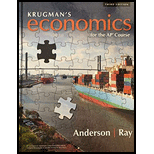
a)
The
a)
Explanation of Solution
The ATC of producing is 12,000, 22,000, and 30,000 units for each of the three choices of fixed cost. And, therefore the total cost of producing 12,000 units of output would be:
With choice 1, the average total cost of producing 12,000 units of output is:
With choice 2, the average total cost of producing 22,000 units of output is:
With choice 3, the average total cost of producing 30,000 units of output is:
Therefore, the firm would make choice 1 because it provides the lowest ATC.
Introduction: Marginal cost is calculated by subtracting the new total cost from the previous one and the average total cost is determined by dividing the total cost by quantity or adding the
b)
The way through which ATC can change in the short run and in the long run
b)
Explanation of Solution
The firm would have adopted choice 1 if it historically produced 12,000 units. The firm would have had an ATC of $1.67 but in the choice of 22,000 units, the ATC increased. Moreover, the firm cannot change its choice of fixed cost in the short run and therefore, the ATC in the short run would be $1.36. Whereas, in the long run, the firm would like to adopt choice 2 as its ATC fall to $1.30.
Introduction: Marginal cost is calculated by subtracting the new total cost from the previous one and the average total cost is determined by dividing the total cost by quantity or adding the average variable cost and average fixed cost.
c)
What the firm should do without believing the change in demand is temporary?
c)
Explanation of Solution
By believing that the increase in demand is temporary, the firm should not change its fixed cost from choice 1 because choice 2 provides greater ATC when output decreases ($1.75 to $1.67) to its original quantity of 12,000 units.
Introduction: Marginal cost is calculated by subtracting the new total cost from the previous one and the average total cost is determined by dividing the total cost by quantity or adding the average variable cost and average fixed cost.
Want to see more full solutions like this?
Chapter 56 Solutions
Krugman's Economics For The Ap® Course

 Principles of Economics (12th Edition)EconomicsISBN:9780134078779Author:Karl E. Case, Ray C. Fair, Sharon E. OsterPublisher:PEARSON
Principles of Economics (12th Edition)EconomicsISBN:9780134078779Author:Karl E. Case, Ray C. Fair, Sharon E. OsterPublisher:PEARSON Engineering Economy (17th Edition)EconomicsISBN:9780134870069Author:William G. Sullivan, Elin M. Wicks, C. Patrick KoellingPublisher:PEARSON
Engineering Economy (17th Edition)EconomicsISBN:9780134870069Author:William G. Sullivan, Elin M. Wicks, C. Patrick KoellingPublisher:PEARSON Principles of Economics (MindTap Course List)EconomicsISBN:9781305585126Author:N. Gregory MankiwPublisher:Cengage Learning
Principles of Economics (MindTap Course List)EconomicsISBN:9781305585126Author:N. Gregory MankiwPublisher:Cengage Learning Managerial Economics: A Problem Solving ApproachEconomicsISBN:9781337106665Author:Luke M. Froeb, Brian T. McCann, Michael R. Ward, Mike ShorPublisher:Cengage Learning
Managerial Economics: A Problem Solving ApproachEconomicsISBN:9781337106665Author:Luke M. Froeb, Brian T. McCann, Michael R. Ward, Mike ShorPublisher:Cengage Learning Managerial Economics & Business Strategy (Mcgraw-...EconomicsISBN:9781259290619Author:Michael Baye, Jeff PrincePublisher:McGraw-Hill Education
Managerial Economics & Business Strategy (Mcgraw-...EconomicsISBN:9781259290619Author:Michael Baye, Jeff PrincePublisher:McGraw-Hill Education





